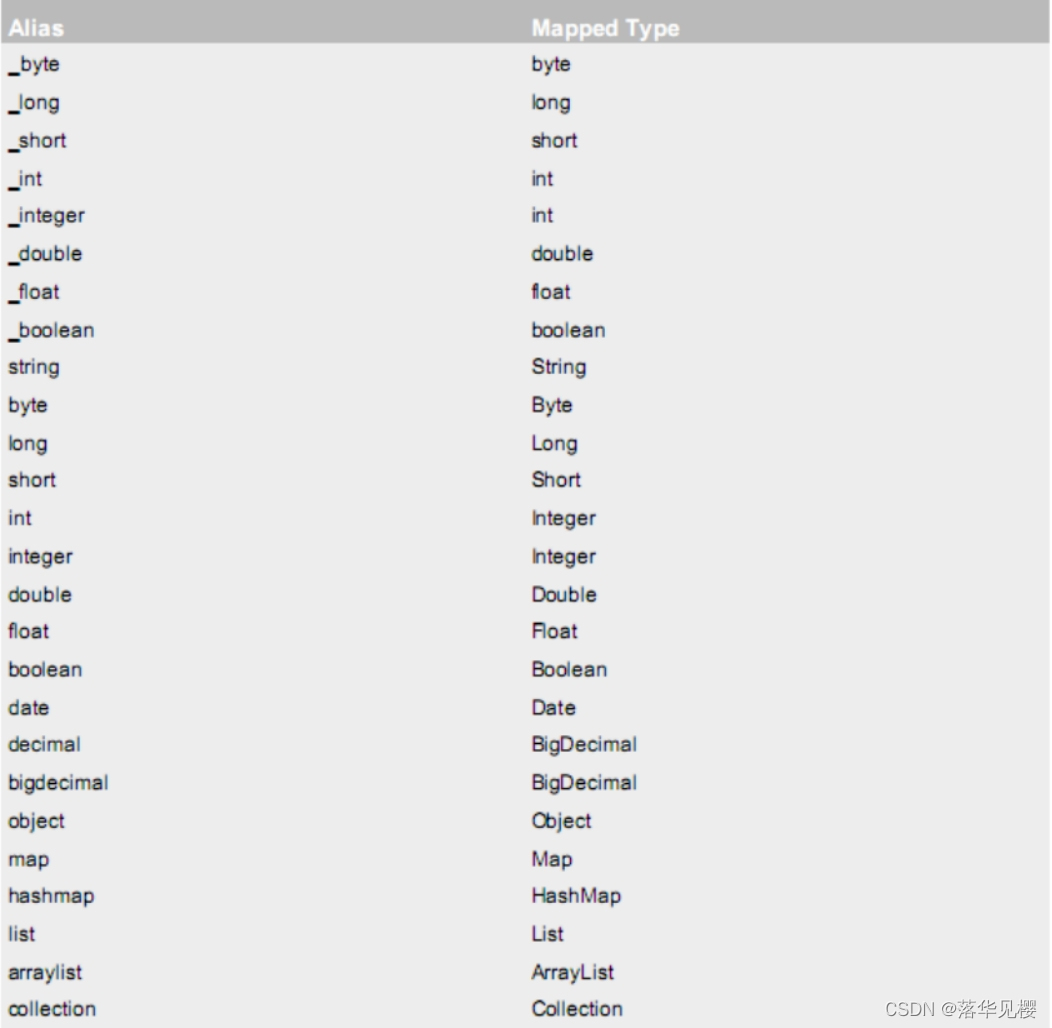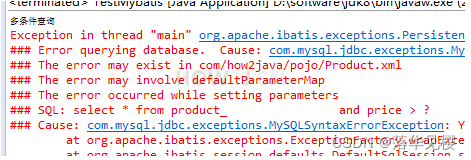2021.12.15
mybatis
配置属性
properties(属性)
property
settings(全局配置参数)
setting
typeAliases(类型别名)
typeAliase
package
typeHandlers(类型处理器)
objectFactory(对象工厂)
plugins(插件)
environments(环境集合属性对象)
environment(环境子属性对象)
transactionManager(事务管理)
dataSource(数据源)
mappers(映射器)
mapper
package
① Properties属性
在使用 properties 标签配置时,我们可以采用两种方式指定属性配置。
第一种:
properties>
property name="jdbc.driver" value="com.mysql.jdbc.Driver"/>
property name="jdbc.url" value="jdbc:mysql://localhost:3306/test"/>
property name="jdbc.username" value="root"/>
property name="jdbc.password" value="root"/>
properties>
第二种:
在classpath下创建db.properties文件
jdbc.driver=com.mysql.jdbc.Driver
jdbc.url=jdbc:mysql://localhost:3306/test
jdbc.username=root
jdbc.password=root
properties url= file:///D:/workspace/day02_test/src/db.properties">properties>
此时我们的 dataSource 标签就变成了引用上面的配置
dataSource type="POOLED">
property name="driver" value="${jdbc.driver}"/>
property name="url" value="${jdbc.url}"/>
property name="username" value="${jdbc.username}"/>
property name="password" value="${jdbc.password}"/>
dataSource>
② typeAliases属性
在前面我们讲的 Mybatis 支持的默认别名,我们也可以采用自定义别名方式来开发
在 mybatis-config.xml 中配置:
typeAliases>
typeAlias alias="user" type="com.tledu.zrz.pojo.User"/>
package name="com.tledu.zrz.pojo"/>
package name="其它包"/>
typeAliases>
③ Mappers属性
Mappers使我们所说的映射器,用于通过mybatis配置文件去找到对应的mapper文件
有三种用法
④Resources
使用相对于类路径的资源
如:
⑤class
使用 mapper 接口类路径
如:
注意:此种方法要求 mapper 接口名称和 mapper 映射文件名称相同,且放在同一个目录中。
⑥Package
注册指定包下的所有 mapper 接口
如:
注意:此种方法要求 mapper 接口名称和 mapper 映射文件名称相同,且放在同一个目录中。
2.Mapper.xml属性
1.#和$区别
#{}表示一个占位符号
通过#{}可以实现 preparedStatement 向占位符中设置值,自动进行 java 类型和 jdbc 类型转换,
#{}可以有效防止 sql 注入。
举例:select * from user where username = ' ' or 1=1 # and passord=''
#{}可以接收简单类型值或 pojo 属性值。 如果 parameterType 传输单个简单类
型值,#{}括号中可以是 value 或其它名称。
可以自动对值添加 ’ ’ 单引号
${}表示拼接 sql 串
通过${}可以将 parameterType 传入的内容拼接在 sql 中且不进行 jdbc 类型转换, ${}可以接收简
单类型值或 pojo 属性值,如果 parameterType 传输单个简单类型值,${}括号中只能是 value。
比如order by id 这种的,以id排序 那么这个id 是没有单引号的,就是简单的SQL拼接,所以我们应该使用${} 而不是#{}
举例: ALTER TABLE (表名) ADD keycode(字段) varchar(500)
2.parameterType 配置参数
我们在上一章节中已经介绍了 SQL 语句传参,使用标签的 parameterType 属性来设定。该属性的取值可以是基本类型,引用类型(例如:String 类型),还可以是实体类类型(POJO 类)。同时也可以使用实体类的包装类,本章节将介绍如何使用实体类的包装类作为参数传递。
注意事项
基本类型和String我们可以直接写类型名称,也可以使用包名.类名的方式
例如 :
java.lang.String
实体类类型,目前我们只能使用全限定类名。
究其原因,是 mybaits 在加载时已经把常用的数据类型注册了别名,从而我们在使用时可以不写包名,而我们的是实体类并没有注册别名,所以必须写全限定类名。在 mybatis 的官方文档的说明(第 19 页)
3.resultType
resultType 属性可以指定结果集的类型,它支持基本类型和实体类类型。
我们在前面的 CRUD 案例中已经对此属性进行过应用了。
需要注意的是,它和 parameterType 一样,如果注册过类型别名的,可以直接使用别名。没有注册过的必须使用全限定类名。
例如:我们的实体类此时必须是全限定类名
同时,当是实体类名称时,还有一个要求,实体类中的属性名称必须和查询语句中的列名保持一致,否则无法实现封装(不区分大小写)
4.resultMap
我们在resultType ,提到在声明返回值类型为实体类型之后,实体中的属性必须和查询语句中的属性对应上,但是我们在开发的过程中也难免会遇到无法对应的情况。比如说我们在进行数据库设计的时候,多个单词往往是用_连接,但是在实体类中的属性往往采用小驼峰的方式命名。这就导致字段名无法对应上,这个时候我们就需要配置resultMap来解决这个问题了。
通过resultMap,我们可以指定查询结果字段和实体属性字段的映射关系。
<resultMap id="userResult" type="User">
<id column="id" property="id" />
<result property="nickname" column="nickname" />
<result property="schoolName" column="school_name" />
</resultMap>配置插件
在mybatis-config.xml中,添加plugins标签配置,表示开启PageHelper插件
<?xml version="1.0" encoding="UTF-8" ?> <!DOCTYPE configuration PUBLIC "-//mybatis.org//DTD Config 3.0//EN" "http://mybatis.org/dtd/mybatis-3-config.dtd"> <configuration> <settings> <!-- 打开延迟加载的开关 --> <setting name="lazyLoadingEnabled" value="true" /> <!-- 将积极加载改为消息加载即按需加载 --> <setting name="aggressiveLazyLoading" value="false"/> </settings> <typeAliases> <package name="com.how2java.pojo"/> </typeAliases> <plugins> <plugin interceptor="com.github.pagehelper.PageInterceptor"></plugin> </plugins> <environments default="development"> ..... </environments> <mappers> ... </mappers> </configuration>修改CategoryMapper.xml
limit注释掉,因为分页相关工作,会由PageHelper去做掉,不需要自己去写了
<?xml version="1.0" encoding="UTF-8"?> <!DOCTYPE mapper PUBLIC "-//mybatis.org//DTD Mapper 3.0//EN" "http://mybatis.org/dtd/mybatis-3-mapper.dtd"> <mapper namespace="com.how2java.pojo"> <select id="listCategory" resultType="Category"> select * from t_category <!-- <if test="start!=null and count!=null"> --> <!-- limit #{start},#{count} --> <!-- </if> --> </select> </mapper>
分页查询测试
查询很有意思,只需要在执行查询所有的调用之前,执行一条语句即可:
PageHelper.offsetPage(0, 5);
public class TestMybatis { public static void main(String[] args) throws IOException, InterruptedException { String resource = "mybatis-config.xml"; InputStream inputStream = Resources.getResourceAsStream(resource); SqlSessionFactory sqlSessionFactory = newSqlSessionFactoryBuilder().build(inputStream); SqlSession session = sqlSessionFactory.openSession(); PageHelper.offsetPage(0, 5); List<Category> cs = session.selectList("listCategory"); for (Category c : cs) { System.out.println(c.getName()); } session.commit(); session.close(); } }
获取总数
public class TestMybatis { public static void main(String[] args) throws IOException, InterruptedException { String resource = "mybatis-config.xml"; InputStream inputStream = Resources.getResourceAsStream(resource); SqlSessionFactory sqlSessionFactory = newSqlSessionFactoryBuilder().build(inputStream); SqlSession session = sqlSessionFactory.openSession(); PageHelper.offsetPage(0, 5); List<Category> cs = session.selectList("listCategory"); for (Category c : cs) { System.out.println(c.getName()); } PageInfo pageInfo = new PageInfo<>(cs); System.out.println("总数:"+pageInfo.getTotal()); System.out.println(pageInfo); session.commit(); session.close(); } }
-------------------------------------------------------------------------------------------------------------------------------------
四、完成模糊查询
模糊查询
1. 修改UserMapper.xml,提供listUserByName查询语句
<select id="listUserByName" parameterType="string" resultType="User"> select * from t_user where username like concat('%',#{0},'%') </select>
2. 测试
@Test public void listUserByName() { SqlSession session = null; try { session = MybatisUtil.getSession(); List<User> list = session.selectList("User.listUserByName","d"); for (User user : list) { System.out.println(user); } } catch (Exception e) { e.printStackTrace(); } finally { MybatisUtil.closeSession(session); } }
多条件查询
结合前面的模糊查询,多一个id大于多少的条件
1. UserMapper.xml 准备sql语句
<select id="listUserByIdAndName" parameterType="map" resultType="User"> select * from t_user where id> #{id} and username like concat('%',#{username},'%') </select>
2. 测试代码
因为是多个参数,而session.selectList()方法又只接受一个参数对象,所以需要把多个参数放在Map里,然后把这个Map对象作为参数传递进去
Map<String,Object> params = new HashMap<>(); params.put("id", 8); params.put("username", "d"); List<User> ulist= session.selectList("User.listUserByIdAndName",params);
-------------------------------------------------------------------------------------------------------------------------------------
五、掌握动态SQL
动态SQL是MyBatis的一个强大特性之一,如果你有使用 JDBC 或其他 相似框架的经验,你就明白条件地串联 SQL 字符串在一起是多么的痛苦,确保不能忘了空 格或在列表的最后省略逗号。动态 SQL 可以彻底处理这种痛苦。
动态 SQL 元素和使用 JSTL 或其他相似的基于 XML 的文本处理器相似。在 MyBatis 之 前的版本中,有很多的元素需要来了解。MyBatis 3 大大提升了它们,现在用不到原先一半 的元素就能工作了。MyBatis 采用功能强大的基于 OGNL 的表达式来消除其他元素。
· if
· choose (when, otherwise)
· where等
用法可参照API MyBatis3.2.3帮助文档(中文版).chm
创建产品表
create table t_product( id int NOT NULL AUTO_INCREMENT, name varchar(30) DEFAULT NULL, price float DEFAULT 0, cid int , PRIMARY KEY (id) )AUTO_INCREMENT=1 DEFAULT CHARSET=utf8;
新增6条产品数据
INSERT INTO t_product VALUES (1,'product a', 88.88, 1); INSERT INTO t_product VALUES (2,'product b', 88.88, 1); INSERT INTO t_product VALUES (3,'product c', 88.88, 1); INSERT INTO t_product VALUES (4,'product x', 88.88, 2); INSERT INTO t_product VALUES (5,'product y', 88.88, 2); INSERT INTO t_product VALUES (6,'product z', 88.88, 2);
创建Product实体类
public class Product { private int id; private String name; private float price; public int getId() { return id; } public void setId(int id) { this.id = id; } public String getName() { return name; } public void setName(String name) { this.name = name; } public float getPrice() { return price; } public void setPrice(float price) { this.price = price; } @Override public String toString() { return "Product [id=" + id + ", name=" + name + ", price=" + price + "]"; }
动态SQL导入
执行不同的条件限定,需要准备两条sql语句
假设需要对Product执行两条sql语句,一个是查询所有,一个是根据名称模糊查询。
那么按照现在的方式,必须提供两条sql语句:listProduct和listProductByName
然后在调用的时候,分别调用它们来执行。
在ProductMapper.xml添加如下代码
<select id="listProduct" resultType="Product"> select * from t_product </select> <select id="listProductByName" resultType="Product"> select * from t_product where name like concat('%',#{name},'%') </select>
在测试类进行测试
System.out.println("查询所有的"); List<Product> ps = session.selectList("listProduct"); for (Product p : ps) { System.out.println(p); } System.out.println("模糊查询"); Map<String,Object> params = new HashMap<>(); params.put("name","a"); List<Product> ps2 = session.selectList("listProductByName",params); for (Product p : ps2) { System.out.println(p); }
if标签
如果Product的字段比较多的话,为了应付各个字段的查询,那么就需要写多条sql语句,这样就变得难以维护。这个时候,就可以使用Mybatis 动态SQL里的if标签
<select id="listProduct" resultType="Product"> select * from t_product <if test="name!=null"> where name like concat('%',#{name},'%') </if> </select>
在测试类进行测试
System.out.println("查询所有的"); List<Product> ps = session.selectList("listProduct"); for (Product p : ps) { System.out.println(p); } System.out.println("模糊查询"); Map<String,Object> params = new HashMap<>(); params.put("name","a"); List<Product> ps2 = session.selectList("listProductByName",params); for (Product p : ps2) { System.out.println(p); }
where标签
基于上一个知识点if 标签进行
在ProductMapper.xml添加如下代码
如果要进行多条件判断,就会写成这样:
<select id="listProduct" resultType="Product"> select * from t_product <if test="name!=null"> where name like concat('%',#{name},'%') </if> <if test="price!=0"> and price > #{price} </if> </select>
这么写的问题是:当没有name参数,却有price参数的时候,执行的sql语句就会是:
select * from t_product and price > 10
这样执行就会报错
这个问题可以通过标签来解决,如代码所示
<select id="listProduct" resultType="Product"> select * from t_product <where> <if test="name!=null"> and name like concat('%',#{name},'%') </if> <if test="price!=null and price!=0"> and price > #{price} </if> </where> </select>
标签会进行自动判断
如果任何条件都不成立,那么就在sql语句里就不会出现where关键字
如果有任何条件成立,会自动去掉多出来的 and 或者 or。
所以在测试代码里
Map<String,Object> params = new HashMap<>(); //params.put("name","a"); params.put("price","10");
这个参数map,无论是否提供值都可以正常执行
set标签
与where标签类似的,在update语句里也会碰到多个字段相关的问题。 在这种情况下,就可以使用set标签:
<update id="updateProduct" parameterType="Product" > update t_product <set> <if test="name != null">name=#{name},</if> <if test="price != null">price=#{price}</if> </set> where id=#{id} </update>
其效果与where标签类似,有数据的时候才进行设置。
测试:
Product p = new Product(); p.setId(6); p.setName("product zz"); p.setPrice(99.99f); session.update("updateProduct",p);
trim标签
trim 用来定制想要的功能,比如where标签就可以用
prefix :内容之前加的前缀
suffix :内容之后加的后缀
prefixOverrides: 属性会忽略通过管道分隔的文本序列
...
来替换
set标签就可以用
...
来替换
测试ProductMapper.xml
<select id="listProduct" resultType="Product"> select * from t_product <trim prefix="WHERE" prefixOverrides="AND |OR "> <if test="name!=null"> name like concat('%',#{name},'%') </if> <if test="price!=null and price!=0"> price > #{price} </if> </trim> </select> <update id="updateProduct" parameterType="Product" > update t_product <trim prefix="SET" suffixOverrides=","> <if test="name != null">name=#{name},</if> <if test="price != null">price=#{price},</if> </trim> where id=#{id} </update>
choose、when、otherwise
类似于Java中的switch case default
在ProductMapper.xml文件中添加如下代码
<select id="listProduct" resultType="Product"> SELECT * FROM t_product <where> <choose> <when test="name != null"> and name like concat('%',#{name},'%') </when> <when test="price !=null and price != 0"> and price > #{price} </when> <otherwise> and id >1 </otherwise> </choose> </where> </select>
在测试类中添加如下代码测试
Map<String,Object> params = new HashMap<>(); // params.put("name","a"); // params.put("price","10"); List<Product> ps = session.selectList("listProduct",params); for (Product p : ps) { System.out.println(p); }
foreach标签
ProductMapper.xml
foreach的主要用在构建in条件中,它可以在SQL语句中进行迭代一个集合。
foreach元素的属性主要有 item,index,collection,open,separator,close。
item集合中每一个元素进行迭代时的别名,
open该语句以什么开始,
separator在每次进行迭代之间以什么符号作为分隔 符,
close以什么结束,
在使用foreach的时候最关键的也是最容易出错的就是collection属性,
该属性是必须指定的,但是在不同情况 下,该属性的值是不一样的,
主要有一下3种情况:
1. 如果传入的是单参数且参数类型是一个List的时候,collection属性值为list
2. 如果传入的是单参数且参数类型是一个array数组的时候,collection的属性值为array
3. 如果传入的参数是多个的时候,我们就需要把它们封装成一个Map了
<select id="listProduct" resultType="Product"> SELECT * FROM t_product WHERE ID in <foreach item="item" index="index" collection="list" open="(" separator="," close=")"> #{item} </foreach> </select>
在测试类中添加如下代码测试
List<Integer> ids = new ArrayList(); ids.add(1); ids.add(3); ids.add(5); List<Product> ps = session.selectList("listProduct",ids); for (Product p : ps) { System.out.println(p); }
ids.add(1);
bind标签
ProductMapper.xml
<!-- 本来的模糊查询方式 --> <!-- <select id="listProduct" resultType="Product"> --> <!-- select * from t_product where name like concat('%',#{0},'%') --> <!-- </select> --> <select id="listProduct" resultType="Product"> <bind name="likename" value="'%' + name + '%'" /> select * from t_product where name like #{likename} </select>
在测试类中添加如下代码测试
Map<String, String> params =new HashMap(); params.put("name", "product"); List<Product> ps = session.selectList("listProduct",params); for (Product p : ps) { System.out.println(p); }
六、关联查询
在项目中,某些实体类之间肯定有关联关系,比如一对一、多对一、一对多、多对多等,在mybatis 中可以通过association和collection,来处理这些关联关系。
1、一对多
对于产品类型来说,一种产品类型就对应了多个产品,那么在mybatis中我们可以通过collections解决。
1.1、创建产品表
create table t_product( id int NOT NULL AUTO_INCREMENT, name varchar(30) DEFAULT NULL, price float DEFAULT 0, cid int , PRIMARY KEY (id) )AUTO_INCREMENT=1 DEFAULT CHARSET=utf8;
1.2、创建产品类型表
create table t_category ( id int(11) NOT NULL AUTO_INCREMENT, name varchar(32) DEFAULT NULL, PRIMARY KEY (id) ) ENGINE=MyISAM AUTO_INCREMENT=1 DEFAULT CHARSET=utf8;
1.3、清空t_category 和 t_product_ 表 新增2条分类数据,id分别是1,2 ;新增6条产品数据,分
别关联上述2条分类数据
delete from t_category; INSERT INTO t_category VALUES (1,'category1'); INSERT INTO t_category VALUES (2,'category2'); delete from t_product; INSERT INTO t_product VALUES (1,'product a', 88.88, 1); INSERT INTO t_product VALUES (2,'product b', 88.88, 1); INSERT INTO t_product VALUES (3,'product c', 88.88, 1); INSERT INTO t_product VALUES (4,'product x', 88.88, 2); INSERT INTO t_product VALUES (5,'product y', 88.88, 2); INSERT INTO t_product VALUES (6,'product z', 88.88, 2);
1.4、创建Product实体类
public class Product { private int id; private String name; private float price; public int getId() { return id; } public void setId(int id) { this.id = id; } public String getName() { return name; } public void setName(String name) { this.name = name; } public float getPrice() { return price; } public void setPrice(float price) { this.price = price; } @Override public String toString() { return "Product [id=" + id + ", name=" + name + ", price=" + price + "]"; }
1.5、创建Category实体
public class Category { private int id; private String name; List<Product> products; public int getId() { return id; } public void setId(int id) { this.id = id; } public String getName() { return name; } public void setName(String name) { this.name = name; } public List<Product> getProducts() { return products; } public void setProducts(List<Product> products) { this.products = products; } @Override public String toString() { return "Category [id=" + id + ", name=" + name + "]"; } }
1.6、创建CategoryMapper.xml
<?xml version="1.0" encoding="UTF-8"?> <!DOCTYPE mapper PUBLIC "-//mybatis.org//DTD Mapper 3.0//EN" "http://mybatis.org/dtd/mybatis-3-mapper.dtd"> <mapper namespace="com.test.pojo"> <resultMap type="Category" id="categoryBean"> <id column="cid" property="id" /> <result column="cname" property="name" /> <!-- 一对多的关系 --> <!-- property: 指的是集合属性的值, ofType:指的是集合中元素的类型 --> <collection property="products" ofType="Product"> <id column="pid" property="id" /> <result column="pname" property="name" /> <result column="price" property="price" /> </collection> </resultMap> <!-- 关联查询分类和产品表 --> <select id="listCategory" resultMap="categoryBean"> select c.*, p.*, c.id 'cid', p.id 'pid', c.name 'cname', p.name 'pname' from t_category c left join t_product p on c.id = p.cid </select> </mapper>
1.7、创建MyBatis测试类
public static void main(String[] args) throws IOException { String resource = "mybatis-config.xml"; InputStream inputStream = Resources.getResourceAsStream(resource); SqlSessionFactory sqlSessionFactory = newSqlSessionFactoryBuilder().build(inputStream); SqlSession session = sqlSessionFactory.openSession(); List<Category> cs = session.selectList("listCategory"); for (Category c : cs) { System.out.println(c); List<Product> ps = c.getProducts(); for (Product p : ps) { System.out.println("\t"+p); } } session.commit(); session.close(); }
2、多对一
对于产品类型来说,一种类型就对应了多个产品,但对于产品来说只能对应一种产品类型,这种情况,在mybatis中就可以通过association 解决。本知识点建立在一对多的基础上讲解多对一关系。
2.1、修改Product.java 添加Category对象属性
public class Product { private int id; ...... private Category category; public Category getCategory() { return category; } public void setCategory(Category category) { this.category = category; } ...... @Override public String toString() { return "Product [id=" + id + ", name=" + name + ", price=" + price + "]"; } }
2.2、创建ProductMapper.xml
<?xml version="1.0" encoding="UTF-8"?> <!DOCTYPE mapper PUBLIC "-//mybatis.org//DTD Mapper 3.0//EN" "http://mybatis.org/dtd/mybatis-3-mapper.dtd"> <mapper namespace="com.hanlin.pojo"> <resultMap type="Product" id="productBean"> <id column="pid" property="id" /> <result column="pname" property="name" /> <result column="price" property="price" /> <!-- 多对一的关系 --> <!-- property: 指的是属性名称, javaType:指的是属性的类型 --> <association property="category" javaType="Category"> <id column="cid" property="id"/> <result column="cname" property="name"/> </association> </resultMap> <!-- 根据id查询Product, 关联将Orders查询出来 --> <select id="listProduct" resultMap="productBean"> select c.*, p.*, c.id 'cid', p.id 'pid', c.name 'cname', p.name 'pname' from t_category c left join t_product p on c.id = p.cid </select> </mapper>
2.3、修改mybatis-config.xml
<?xml version="1.0" encoding="UTF-8" ?> <!DOCTYPE configuration PUBLIC "-//mybatis.org//DTD Config 3.0//EN" "http://mybatis.org/dtd/mybatis-3-config.dtd"> <configuration> <typeAliases> <package name="com.mjw.pojo"/> </typeAliases> <environments default="development"> <environment id="development"> <transactionManager type="JDBC"/> <dataSource type="POOLED"> <property name="driver" value="com.mysql.jdbc.Driver"/> <property name="url" value="jdbc:mysql://localhost:3306/ssm?characterEncoding=UTF-8"/> <property name="username" value="root"/> <property name="password" value="admin"/> </dataSource> </environment> </environments> <mappers> <mapper resource="com/mjw/pojo/Category.xml"/> <mapper resource="com/mjw/pojo/Product.xml"/> </mappers> </configuration>
2.4、在测试类中测试
public static void main(String[] args) throws IOException { String resource = "mybatis-config.xml"; InputStream inputStream = Resources.getResourceAsStream(resource); SqlSessionFactory sqlSessionFactory = newSqlSessionFactoryBuilder().build(inputStream); SqlSession session = sqlSessionFactory.openSession(); List<Product> ps = session.selectList("listProduct"); for (Product p : ps) { System.out.println(p+" 对应的分类是 \t "+ p.getCategory()); } session.commit(); session.close(); }







 本文详细解读了Mybatis的配置属性、类型别名、映射器、动态SQL及关联查询,包括properties配置、typeAliases自定义别名、mappers映射器使用方法、动态SQL的if、where、foreach等标签,以及如何处理一对一、一对多和多对一的关联查询。
本文详细解读了Mybatis的配置属性、类型别名、映射器、动态SQL及关联查询,包括properties配置、typeAliases自定义别名、mappers映射器使用方法、动态SQL的if、where、foreach等标签,以及如何处理一对一、一对多和多对一的关联查询。


















 5043
5043

 被折叠的 条评论
为什么被折叠?
被折叠的 条评论
为什么被折叠?








